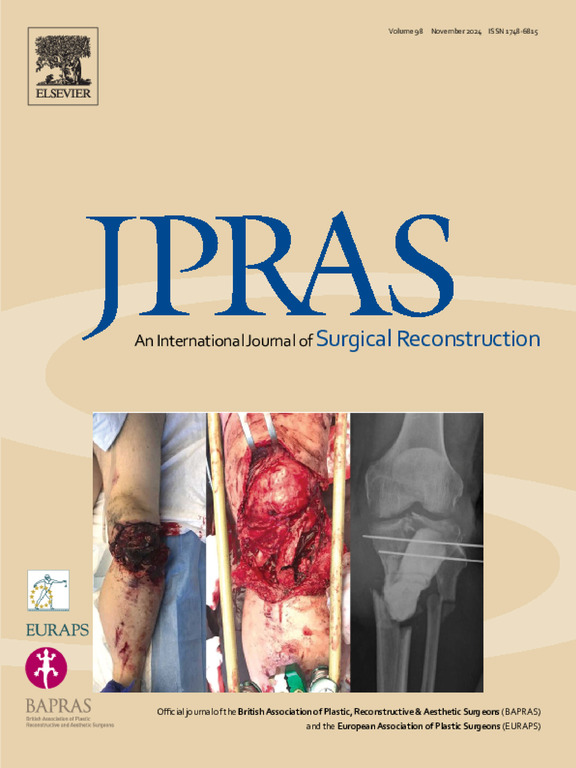Advanced reconstructive techniques following orbital exenteration: The role of LCFA free flaps
IF 2
3区 医学
Q2 SURGERY
Journal of Plastic Reconstructive and Aesthetic Surgery
Pub Date : 2025-02-01
DOI:10.1016/j.bjps.2024.11.030
引用次数: 0
Abstract
Background
Orbital exenteration is a severe and disabling surgical procedure that involves the removal of all orbital contents. Effective reconstruction is crucial to managing the resulting defects. This study aims to propose a reconstructive algorithm utilizing free flaps derived from the lateral circumflex femoral artery (LCFA) system for orbital exenteration defects, based on our clinical experience.
Patients and methods
Patients who underwent orbital exenteration and subsequent reconstruction using LCFA-based free flaps between January 2013 and January 2022 were included in this study.
Results
A total of 44 patients underwent orbital exenteration, followed by LCFA free flap reconstruction. The choice of reconstructive technique depended on defect type and dura mater exposure, adhering to the proposed algorithm. The procedures included 20 standard ALT (Anterolateral thigh) flaps, 13 chimeric ALT flaps, 1 SALT chimeric flap with skin grafting, 7 SALT flaps with skin grafting, and 3 buried SALT flaps. Complications were recorded in 10 cases at the recipient site and 2 cases at the donor site.
Conclusion
Orbital exenteration presents significant challenges both surgically and reconstructively, with a high risk of local recurrence and postoperative mortality. The reconstruction algorithm using LCFA-based free flaps, as proposed in this study, may guide surgeons in selecting the most appropriate technique, tailored to the specific defect and considering postoperative treatments such as adjuvant radiotherapy.
眶内剜除后的先进重建技术:LCFA游离皮瓣的作用。
背景:眶内清除术是一种严重且致残性的手术,包括移除所有眶内内容物。有效的重建对于管理产生的缺陷是至关重要的。本研究的目的是根据我们的临床经验,提出一种利用来自旋股外侧动脉(LCFA)系统的自由皮瓣修复眶内缺损的重建算法。患者和方法:本研究纳入了2013年1月至2022年1月期间使用基于lcfa的游离皮瓣进行眶内清除和随后重建的患者。结果:44例患者行眶内清除术,术后行LCFA游离皮瓣重建。重建技术的选择取决于缺陷类型和硬脑膜暴露,坚持所提出的算法。手术包括标准ALT(大腿前外侧)皮瓣20个,ALT嵌合皮瓣13个,SALT嵌合皮瓣植皮1个,SALT植皮7个,埋地SALT皮瓣3个。受者10例,供者2例。结论:眼窝摘除在手术和重建方面都面临着巨大的挑战,具有很高的局部复发和术后死亡率。本研究提出的基于lcfa的自由皮瓣重建算法,可以指导外科医生根据具体缺陷选择最合适的技术,并考虑术后治疗,如辅助放疗。
本文章由计算机程序翻译,如有差异,请以英文原文为准。
求助全文
约1分钟内获得全文
求助全文
来源期刊
CiteScore
3.10
自引率
11.10%
发文量
578
审稿时长
3.5 months
期刊介绍:
JPRAS An International Journal of Surgical Reconstruction is one of the world''s leading international journals, covering all the reconstructive and aesthetic aspects of plastic surgery.
The journal presents the latest surgical procedures with audit and outcome studies of new and established techniques in plastic surgery including: cleft lip and palate and other heads and neck surgery, hand surgery, lower limb trauma, burns, skin cancer, breast surgery and aesthetic surgery.

 求助内容:
求助内容: 应助结果提醒方式:
应助结果提醒方式:


